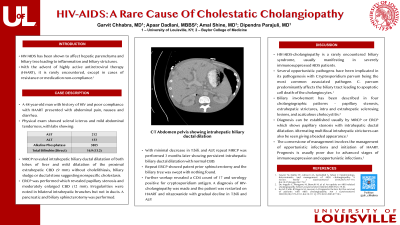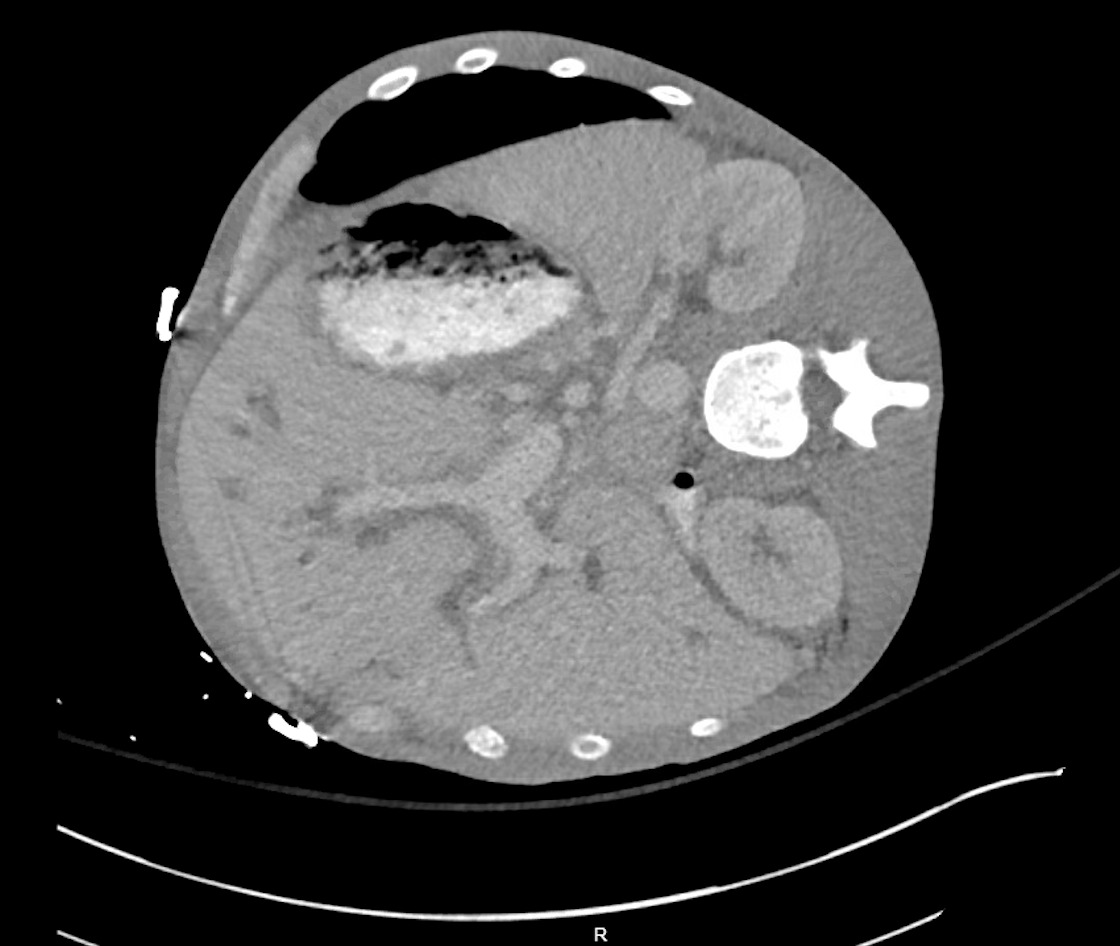Back


Poster Session E - Tuesday Afternoon
Category: Liver
E0522 - HIV-AIDS: A Rare Cause of Cholestatic Cholangiopathy
Tuesday, October 25, 2022
3:00 PM – 5:00 PM ET
Location: Crown Ballroom

Has Audio

Garvit Chhabra, MD
University of Louisville
Louisville, KY
Presenting Author(s)
Garvit Chhabra, MD1, Apaar Dadlani, MBBS1, Amal Shine, MD2, Dipendra Parajuli, MD1
1University of Louisville, Louisville, KY; 2University of Louisville School of Medicine, Louisville, KY
Introduction: HIV/AIDS has been shown to affect hepatic parenchyma and biliary tree leading to inflammation and biliary strictures. With the advent of highly active antiretroviral therapy (HAART), it is rarely encountered, except in cases of resistance or medication non-compliance.
Case Description/Methods: A 48-year-old man with history of HIV and poor compliance with HAART presented with abdominal pain, nausea and diarrhea. Physical exam showed scleral icterus and mild abdominal tenderness, with labs showing a T.bili. 16.9, AST 212, ALT 133, and ALP 3885. MRCP revealed intrahepatic biliary ductal dilatation of both lobes of liver and mild dilatation of the proximal extrahepatic CBD (9 mm) without cholelithiasis, biliary sludge or ductal stone suggesting nonspecific cholestasis. ERCP was performed which revealed papillary stenosis and moderately enlarged CBD (12 mm). Irregularities were noted in bilateral intrahepatic branches but not in ducts. A pancreatic and biliary sphincterotomy was performed. With minimal decrease in T.bili. and ALP, repeat MRCP was performed 3 months later showing persistent intrahepatic biliary ductal dilatation with normal CBD. Repeat ERCP showed patent prior sphincterotomy and the biliary tree was swept with nothing found. Further workup revealed a CD4 count of 17 and serology positive for cryptosporidium antigen. A diagnosis of HIV-cholangiopathy was made and the patient was restarted on HAART and nitazoxanide with gradual decline in T.bili and ALP.
Discussion: HIV/AIDS-cholangiopathy is a rarely encountered biliary syndrome, usually manifesting in severely immunosuppressed AIDS patients. Several opportunistic pathogens have been implicated in its pathogenesis with Cryptosporidium parvum being the most commonly associated pathogen. C. parvum predominantly affecting the biliary tract leading to apoptotic cell death of the cholangiocytes. Biliary involvement has been described in four cholangiographic patterns – papillary stenosis, extrahepatic strictures, intra and extrahepatic sclerosing lesions, and acalculous cholecystitis. Diagnosis can be established usually by MRCP or ERCP which shows papillary stenosis with intrahepatic ductal dilatation. Alternating multifocal intrahepatic strictures can also be seen giving a beaded appearance. The cornerstone of management involves the management of opportunistic infections with the initiation of HAART. The prognosis is usually poor due to advanced stages of immunosuppression and multiple opportunistic infections.

Disclosures:
Garvit Chhabra, MD1, Apaar Dadlani, MBBS1, Amal Shine, MD2, Dipendra Parajuli, MD1. E0522 - HIV-AIDS: A Rare Cause of Cholestatic Cholangiopathy, ACG 2022 Annual Scientific Meeting Abstracts. Charlotte, NC: American College of Gastroenterology.
1University of Louisville, Louisville, KY; 2University of Louisville School of Medicine, Louisville, KY
Introduction: HIV/AIDS has been shown to affect hepatic parenchyma and biliary tree leading to inflammation and biliary strictures. With the advent of highly active antiretroviral therapy (HAART), it is rarely encountered, except in cases of resistance or medication non-compliance.
Case Description/Methods: A 48-year-old man with history of HIV and poor compliance with HAART presented with abdominal pain, nausea and diarrhea. Physical exam showed scleral icterus and mild abdominal tenderness, with labs showing a T.bili. 16.9, AST 212, ALT 133, and ALP 3885. MRCP revealed intrahepatic biliary ductal dilatation of both lobes of liver and mild dilatation of the proximal extrahepatic CBD (9 mm) without cholelithiasis, biliary sludge or ductal stone suggesting nonspecific cholestasis. ERCP was performed which revealed papillary stenosis and moderately enlarged CBD (12 mm). Irregularities were noted in bilateral intrahepatic branches but not in ducts. A pancreatic and biliary sphincterotomy was performed. With minimal decrease in T.bili. and ALP, repeat MRCP was performed 3 months later showing persistent intrahepatic biliary ductal dilatation with normal CBD. Repeat ERCP showed patent prior sphincterotomy and the biliary tree was swept with nothing found. Further workup revealed a CD4 count of 17 and serology positive for cryptosporidium antigen. A diagnosis of HIV-cholangiopathy was made and the patient was restarted on HAART and nitazoxanide with gradual decline in T.bili and ALP.
Discussion: HIV/AIDS-cholangiopathy is a rarely encountered biliary syndrome, usually manifesting in severely immunosuppressed AIDS patients. Several opportunistic pathogens have been implicated in its pathogenesis with Cryptosporidium parvum being the most commonly associated pathogen. C. parvum predominantly affecting the biliary tract leading to apoptotic cell death of the cholangiocytes. Biliary involvement has been described in four cholangiographic patterns – papillary stenosis, extrahepatic strictures, intra and extrahepatic sclerosing lesions, and acalculous cholecystitis. Diagnosis can be established usually by MRCP or ERCP which shows papillary stenosis with intrahepatic ductal dilatation. Alternating multifocal intrahepatic strictures can also be seen giving a beaded appearance. The cornerstone of management involves the management of opportunistic infections with the initiation of HAART. The prognosis is usually poor due to advanced stages of immunosuppression and multiple opportunistic infections.

Figure: CT Abdomen pelvis showing intrahepatic biliary ductal dilation
Disclosures:
Garvit Chhabra indicated no relevant financial relationships.
Apaar Dadlani indicated no relevant financial relationships.
Amal Shine indicated no relevant financial relationships.
Dipendra Parajuli indicated no relevant financial relationships.
Garvit Chhabra, MD1, Apaar Dadlani, MBBS1, Amal Shine, MD2, Dipendra Parajuli, MD1. E0522 - HIV-AIDS: A Rare Cause of Cholestatic Cholangiopathy, ACG 2022 Annual Scientific Meeting Abstracts. Charlotte, NC: American College of Gastroenterology.
